The Most Impressive Catches of 2020 by Species
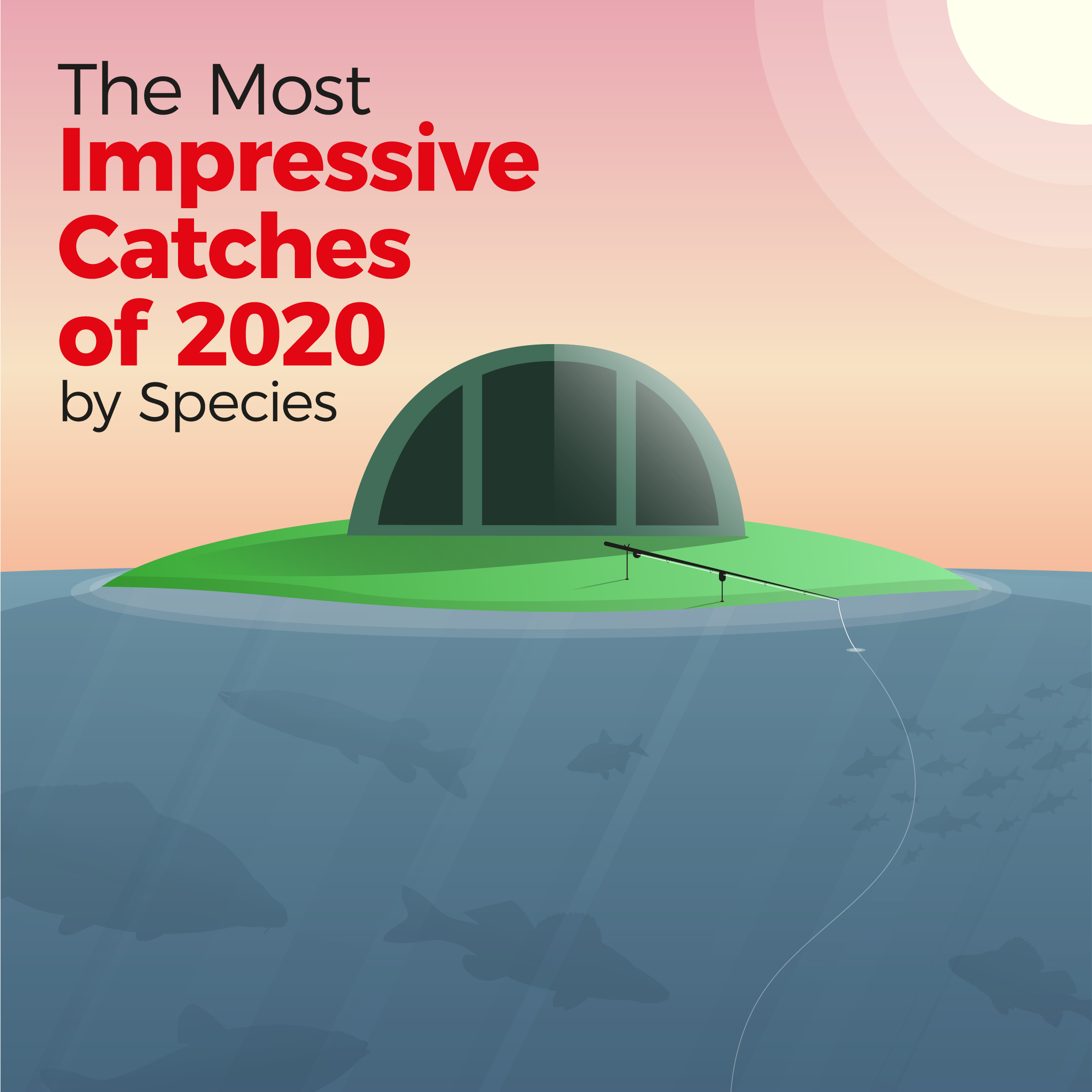
2020 has not been without its ups and downs but to celebrate all that was great for the angling community in the past year we have collected the most impressive catches across most freshwater species across the UK, France, Germany and Netherlands.
Why are these 'Unofficial' Catches?
The catches recorded below are an 'unofficial round-up' of the most impressive catches shared with Angling Direct in 2020. We're labelling it "unofficial" because it's just a bit of fun and the criteria for official records includes legal aspects and plenty of disagreement amongst anglers that we do not wish to get buried in. Although many of these catches were not submitted to organisations such as the British Record Fish Committee for official titles, we think a big catch is not only a great way to reflect and celebrate achievements of anglers but a way to motive anglers in the upcoming year to beat that PB!
The Most Impressive Catches of 2020 by Species
Atlantic Salmon (Salmo salar)
The anadromous fish, also known as Salmo salar have brown to bronze-coloured bodies with dark vertical bars and red and black spots.
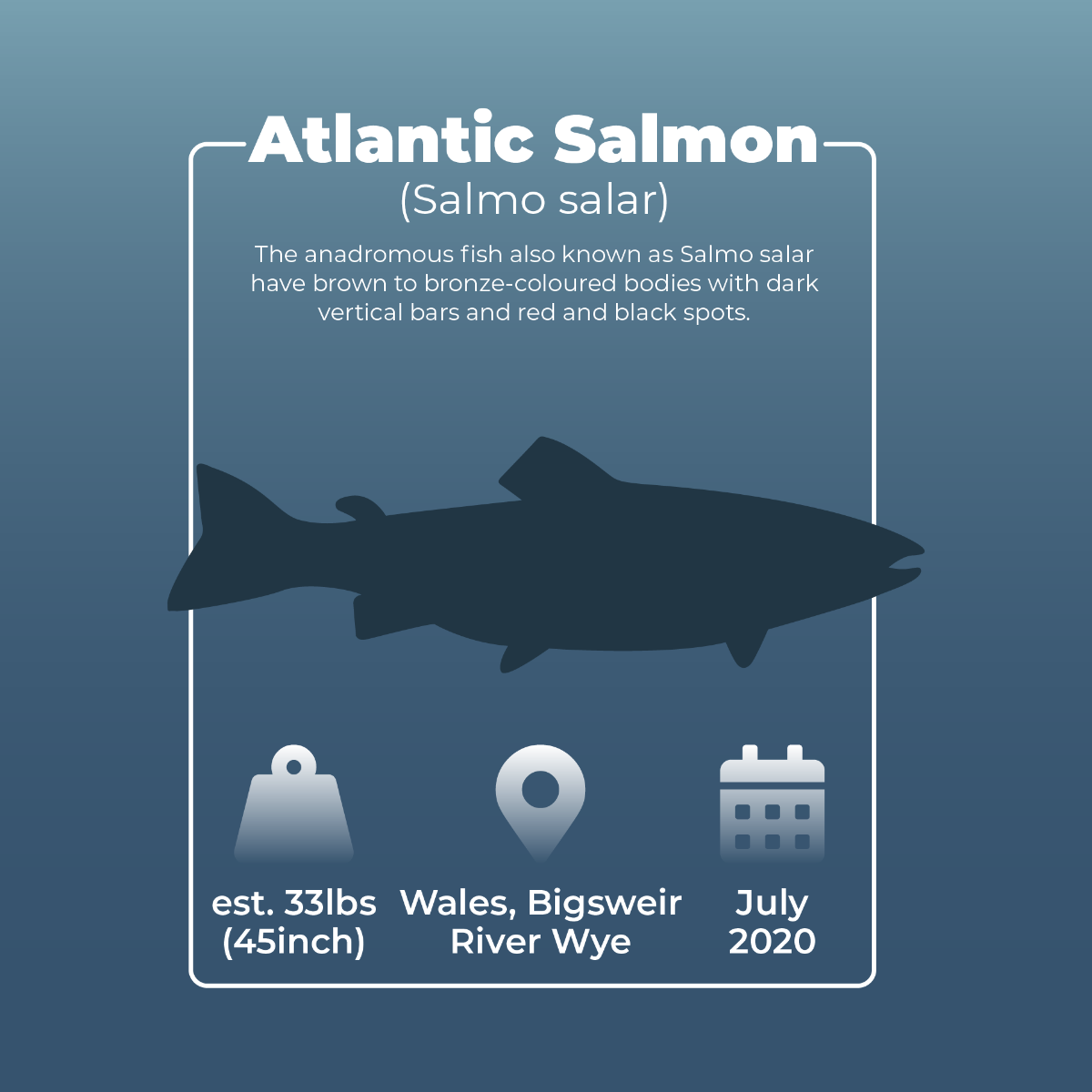
TOP TIP: With a variety of flies to choose from, keep things simple with a selection of buzzers, nymphs and emerging patterns as these suit salmon just under the surface.
Source: “Salmon Catches”. The Fishing Passport. 2020.
Barbel (Barbus barbus)
Easy to identify, Barbel have four barbels on its face, slim and are usually golden bronze with a creamy white belly.
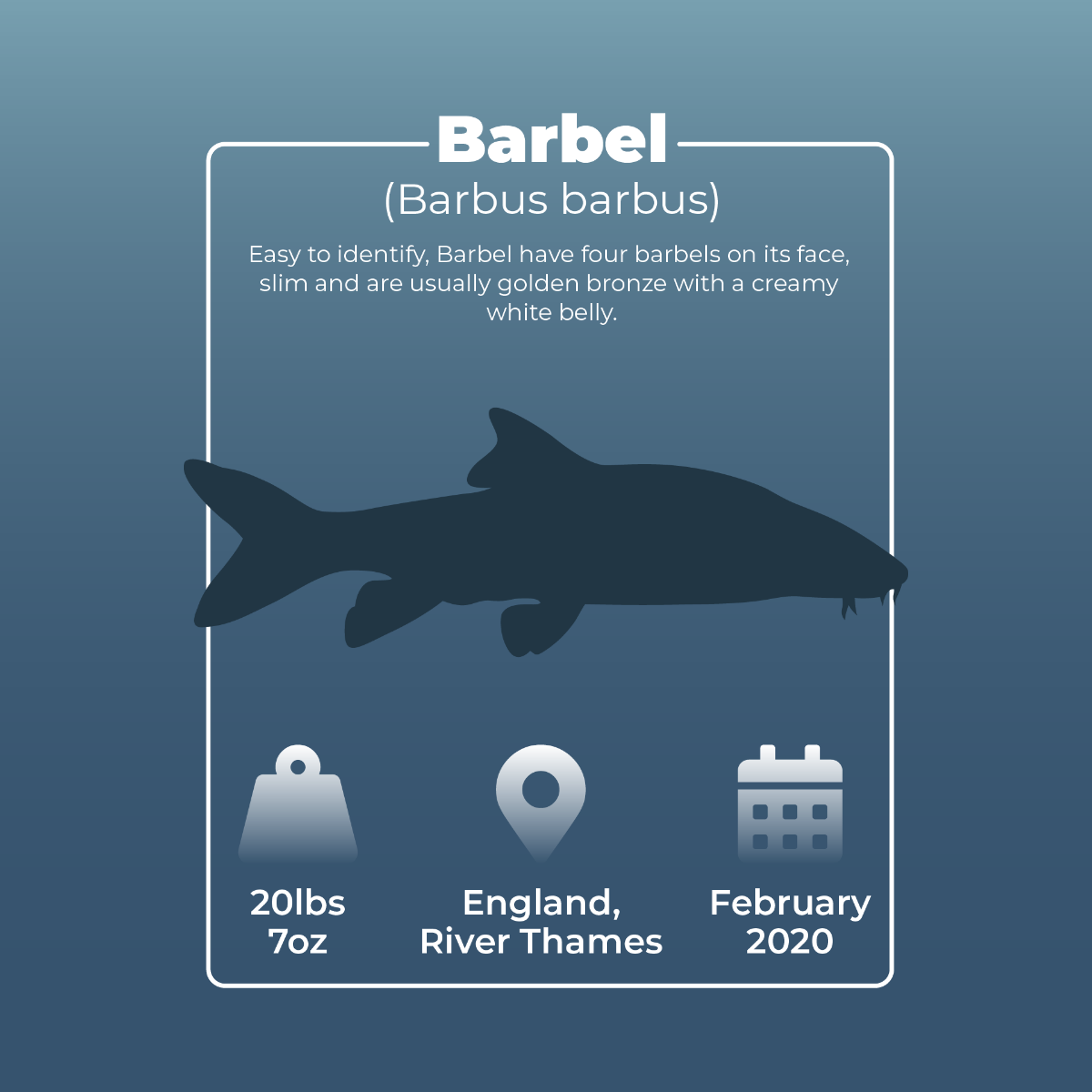
TOP TIP: Barbel can be caught on a manner of baits from hemp and snails in a groundbait mix to soaked pellets and bait pastes. When fishing at night, have a selection of boilies and liquid boosters at the ready!
Source: “Monster Thames Barbel Spins Scales to Over 20lb”. Angling Times. 2020.
Common Bronze Bream (Abramis brama)
Often called Skimmers when small, Common Bream are a deep-bodied fish with a high back and flattened sides. Commons tend to be dark brown /greyish on the back and bronze elsewhere and covered in slime.
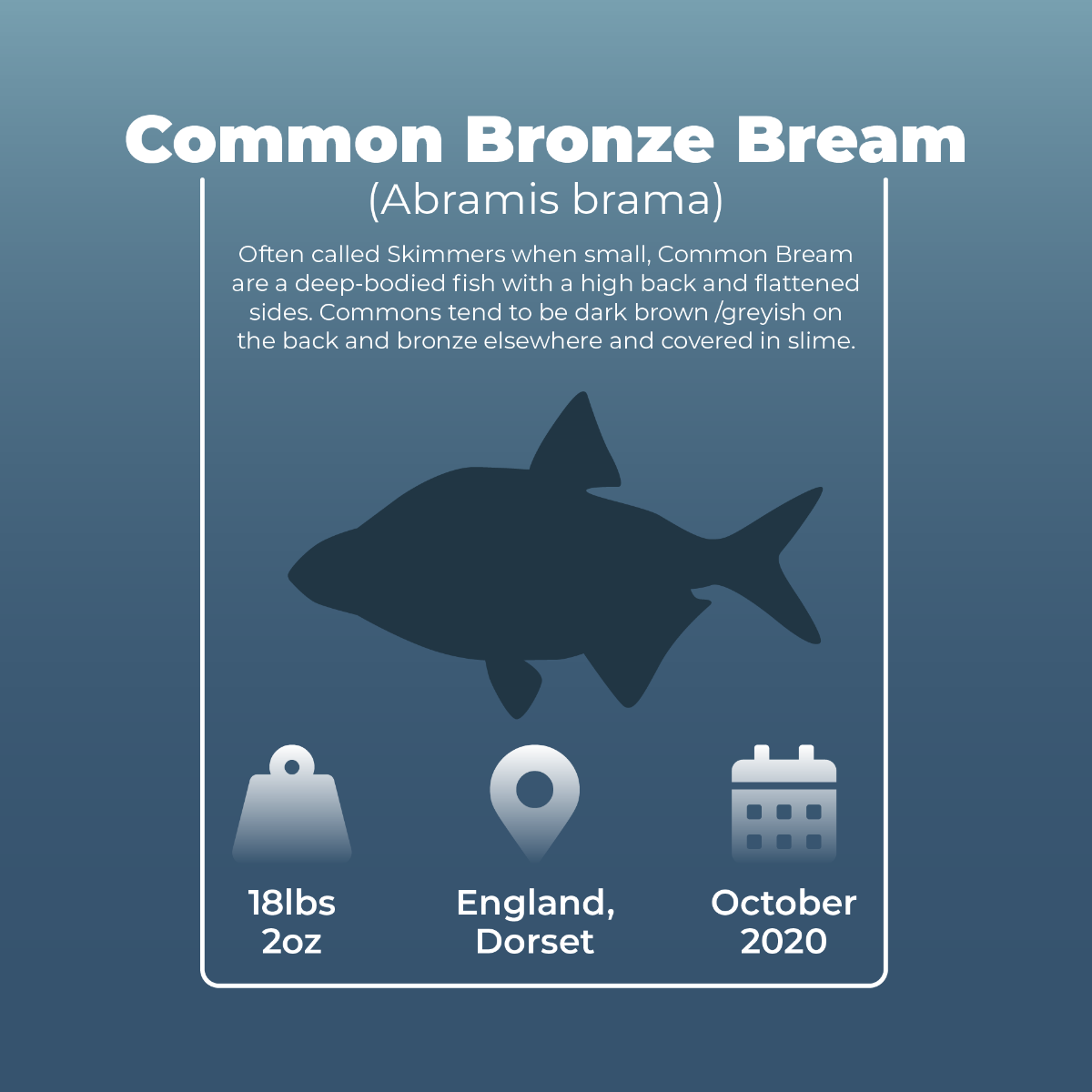
TOP TIP: Although Bream eat everything from maggots through to boilies, a great bream bait would be a designated fishmeal type groundbait, along with pellets, maggots, sweetcorn and casters. This will get them grubbing around. They also love additives like brasum and molasses. For hookbait try a 12mm fishmeal boilie, a worm, or a cocktail of baits, for example, a worm and grain of corn!
Source: "Tim Jackson 18lb 2oz Bream". Drennan Catch Reports. 2020.
Silver Bream (Blicca bjoerkna)
Bright silver in colour, with a slim and deep body, Silver Bream have a unique, V-shaped pattern on its underbelly which is formed by its scales from each side of its body meeting.
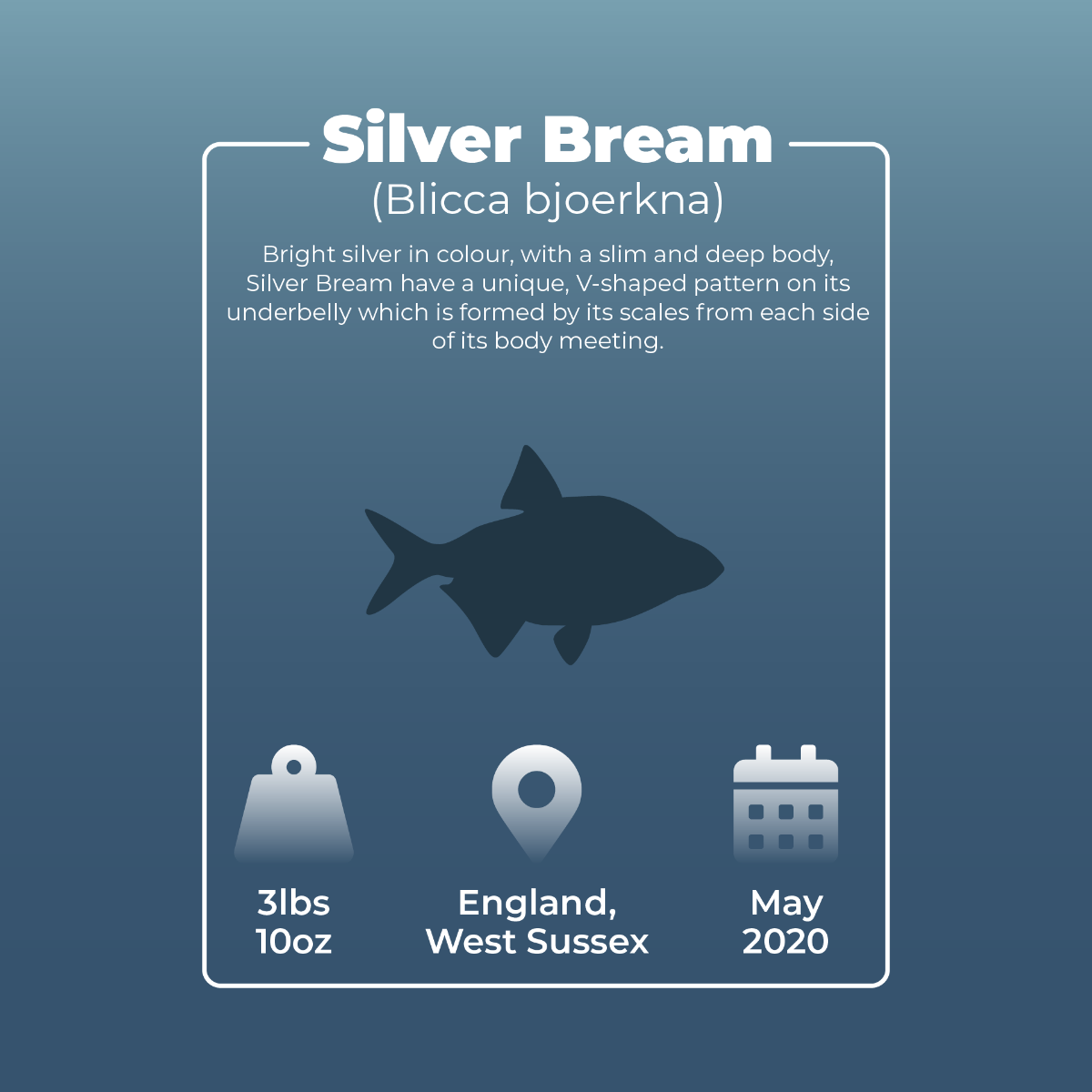
TOP TIP: Worms are undoubtedly the key attractor for specimen silvers, but remember to use a host of other particles to keep the fish occupied such as corn, dyed pellets and casters. Corn is not only a fantastic feed (because it is relatively small-fish-proof) but it also doubles up as a great hook bait and is extremely reliable for bream.
Source: "British silver bream record smashed! 2020-05-26". Anglers Mail. 2020
Common Carp (Cyprinus carpio {communia} )
Common Carp are normally dark brown/bronze in colour and covered in a mesh-like pattern all over its body. Its barbules and underslung mouth is specifically for bottom-feeding.
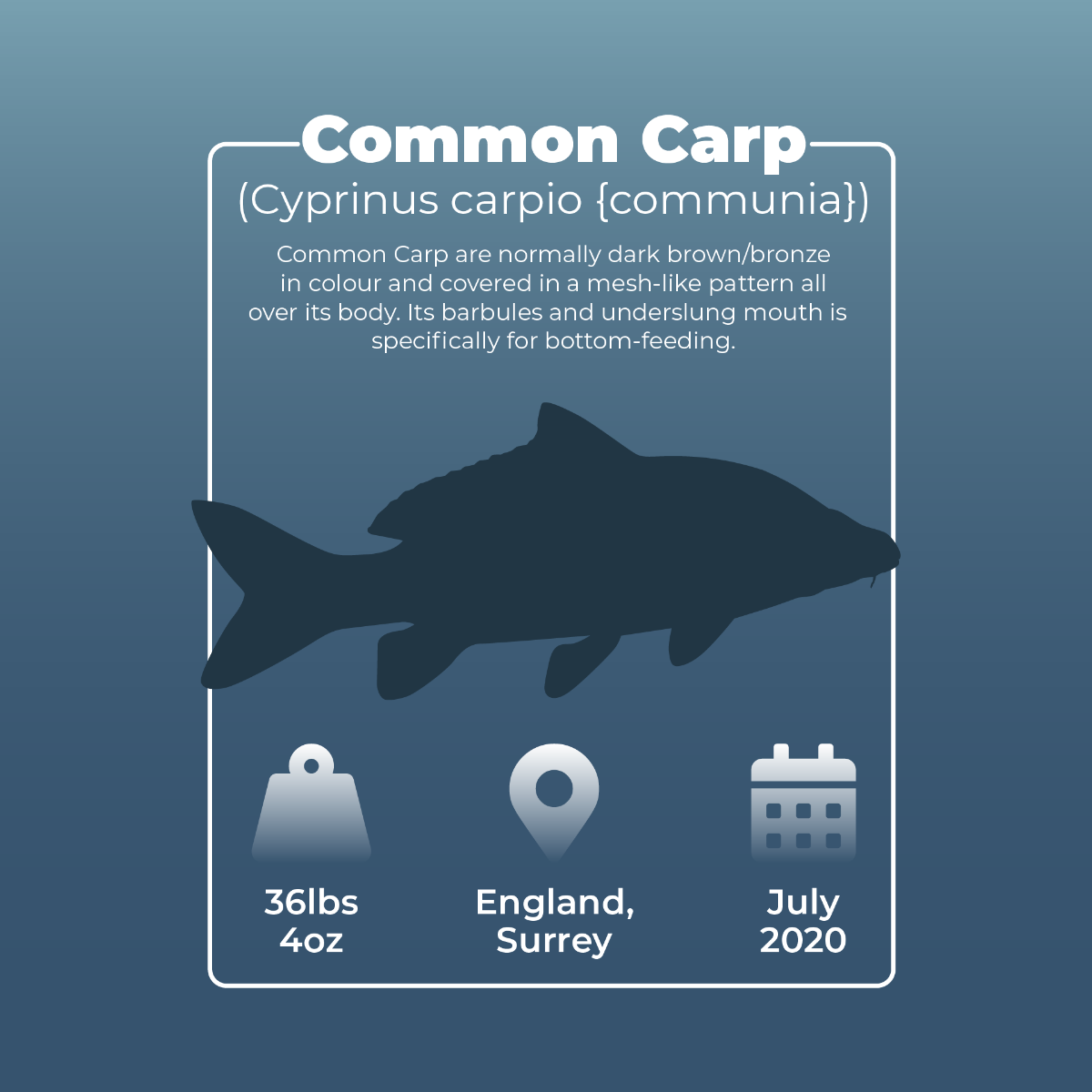
TOP TIP: Like many fish, commons love bread! Over the past few years the popularity of fishing popped-up bread has soared, its been one of the top 'go to' methods on commercial fisheries in the winter months.
Source: “Tench Rig Fool Big Common Not Caught for Nine Years”. Angling Times. 2020.
Crucian Carp (Carassius carassius)
Shaped similar to a traditional common carp, Crucian boast very small scales covering the entire flank, with a distinctive lateral line.
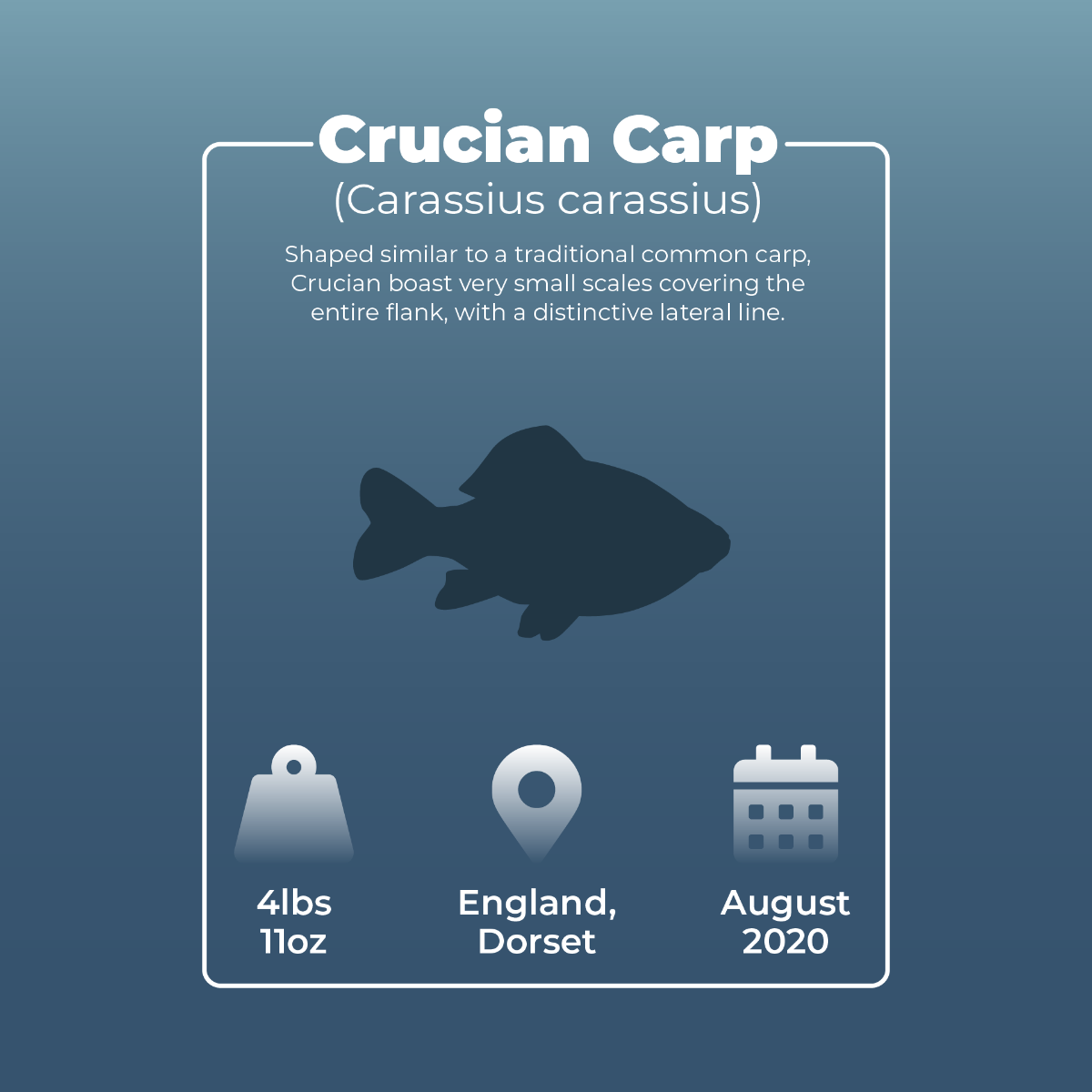
TOP TIP: Float fishing for crucian can be incredibly effective, especially when fishing at such close range as it makes feeding much more accurate. Finesse is important when fishing for crucians so try 2mm pellets on loose feed with your hookbait being either soft 6mm pellets or single grains of corn.
Source: “British Record Crucian Carp The Full Story”. Angling Times. 2020.
F1 Carp
A crossbreed of a Crucian carp and a Common carp, the F1 have just two barbles rather than four and are a favourite amongst match and coarse anglers for year-round feeding.
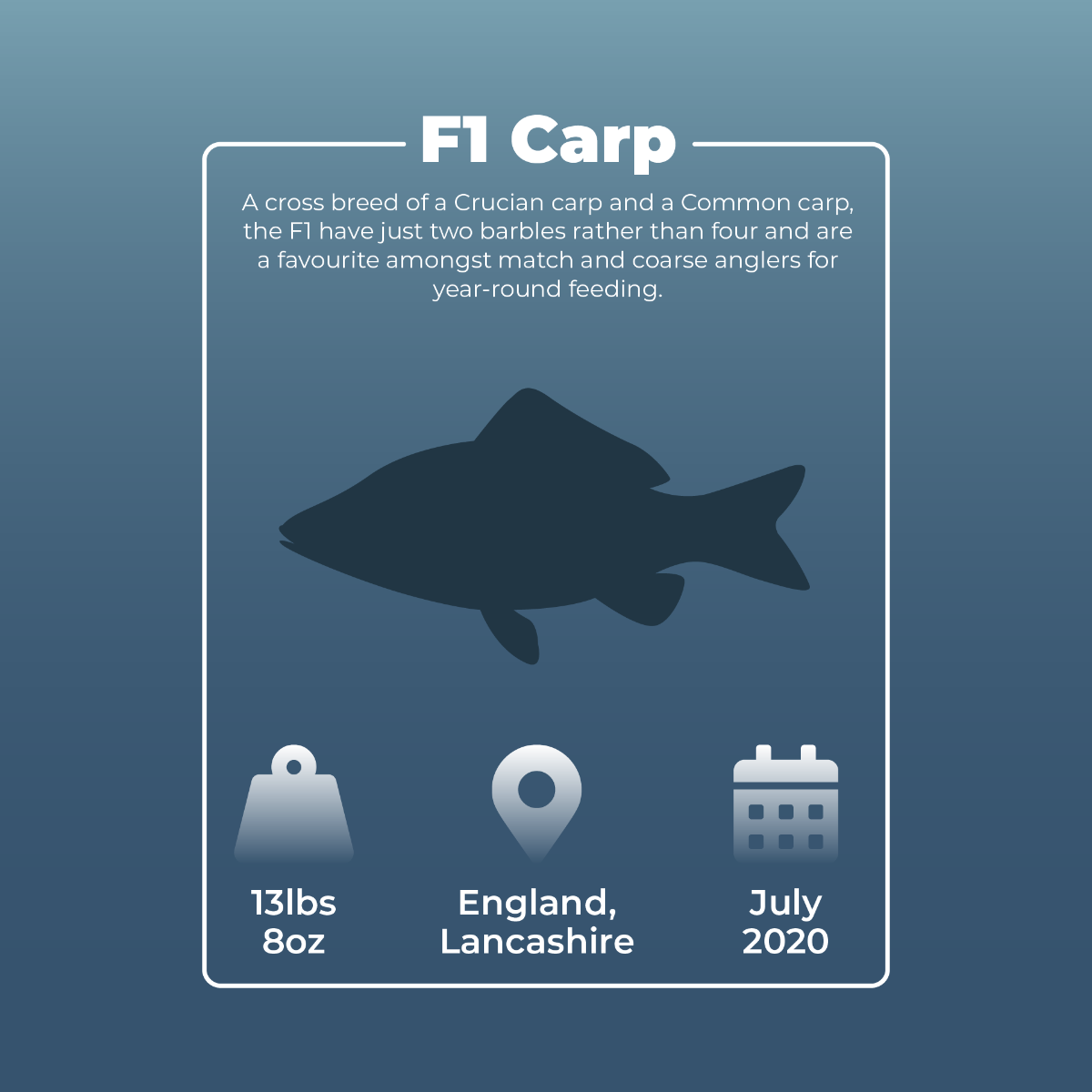
TOP TIP: In colder waters fishing for F1’s with a method feeder full of a dead maggot mix will certainly get you some attraction but in the warmer conditions, try hard pellets over sloppy groundbait mixes especially in shallow waters.
Source: “Biggest F1 Ever Landed. Angling Times”. 2020.
Grass Carp (Ctenopharyngodon idella)
Grass Carp have an elongated body with minuscule, tightly packed scales and unlike some other carp, they don’t have barbules and are often delicate surface feeders.
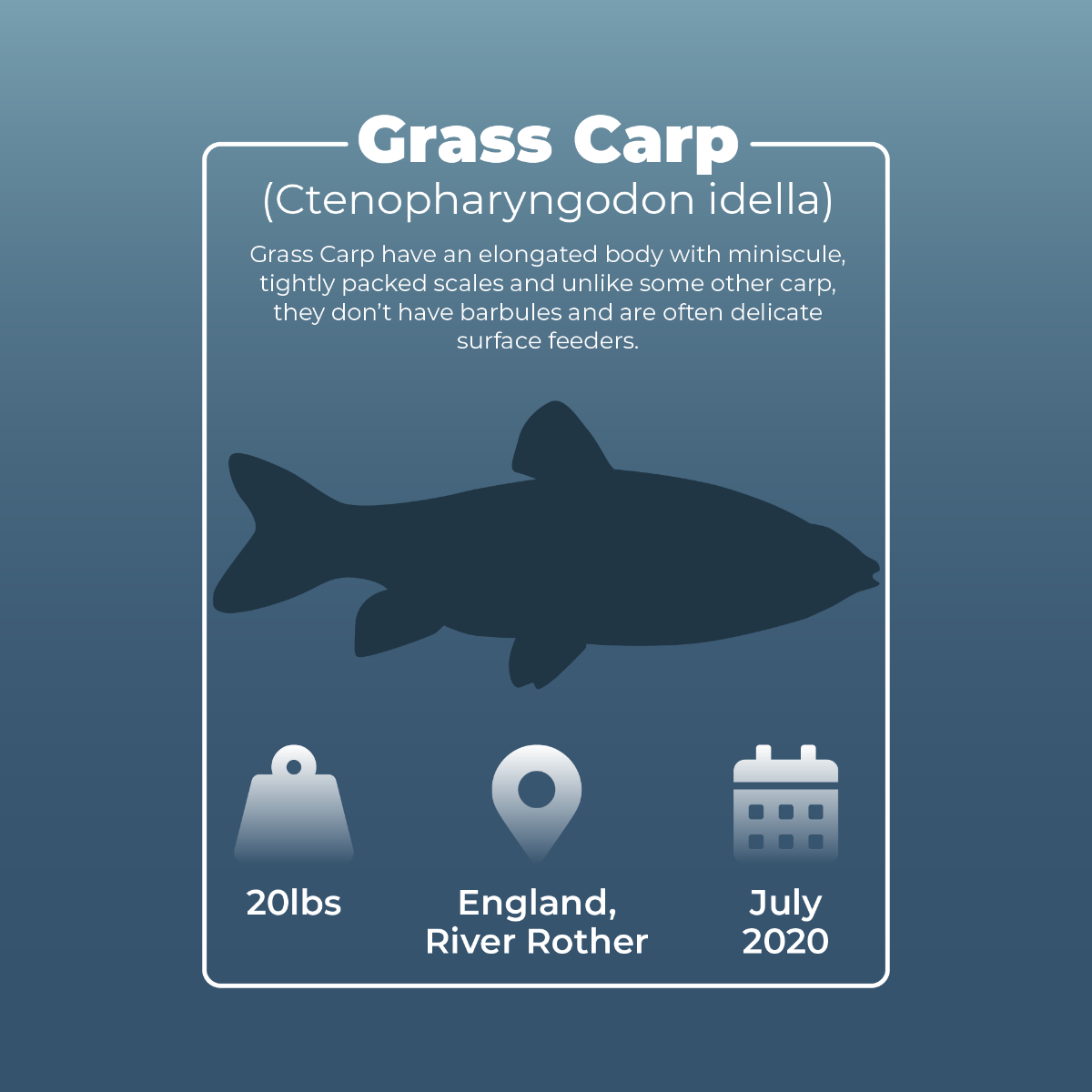
TOP TIP: Despite their size, Grass carp have large appetites, loving to eat anything from aquatic plants to invertebrates and molluscs. Options that are more likely to be in your bait box include, sweetcorn, tiger nuts, hemp and fruity boilies!
Source: “Giant Albino Grass Carp from A River”. Angling Times. 2020.
Leather Carp (Cyprinus carpio {corium} )
An artificially bred variety of Common Carp, Leather Carp have a lack of scales and almost leather-like skin and prefers large bodies of slow or standing water.
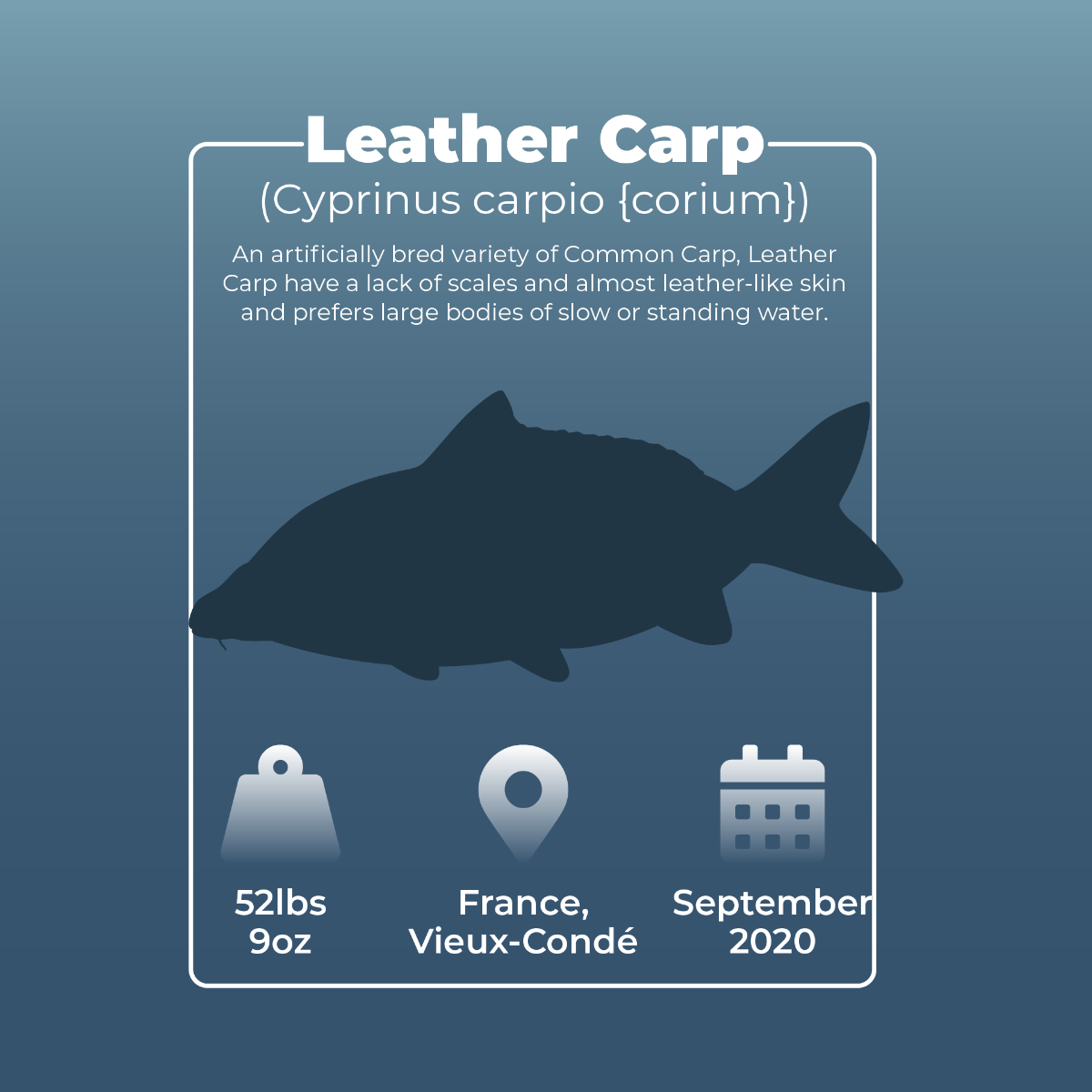
TOP TIP: The simplest rig can often catch the biggest of fish. It is possible to catch loads of big carp through stalking with freelined bread, worms and surface baits like floating pellets or mixer biscuits.
Source: “Leather Carp caught in Vieux-Condé by Jeremy Debieve”. Fish Friender. 2020.
Mirror Carp (Cyprinus carpio)
Mirrors possess irregular scaling, making it easy to identify individual mirrors by sight. Some of these patterns can form known formations such as a Linear.
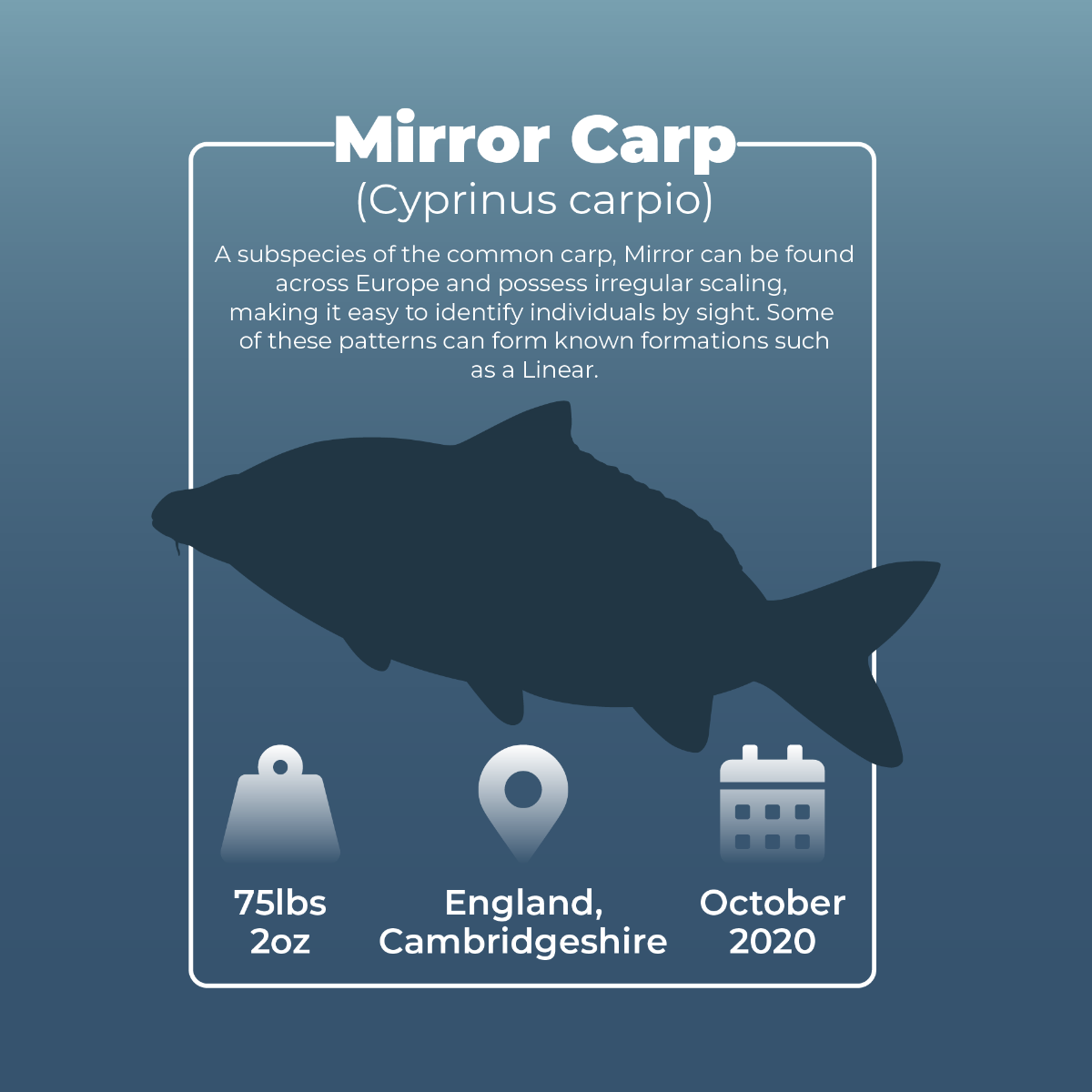
TOP TIP: Usually feeding near the surface, especially in summer, Mirrors love anything from corn, small pellets, dog biscuits and cat biscuits! The key is to not be predictable so regularly change your floating baits. The same goes for your hookbaits; try a piece of trimmed cork, a popup boilie, or even a fake, everlasting dog biscuit imitation bait.
Source: “New King of Holme Fen Fishery – 75lbs 2oz Carp Caught in Cambridgeshire”. Angling Direct Blog. 2020.
Chub (Leuciscus cephalus)
The Leuciscus cephalus or Chub, have a blunt snout, rounded body and very large mouth. With a greenish back but yellow-white underbelly, the chub can be confused with dace.
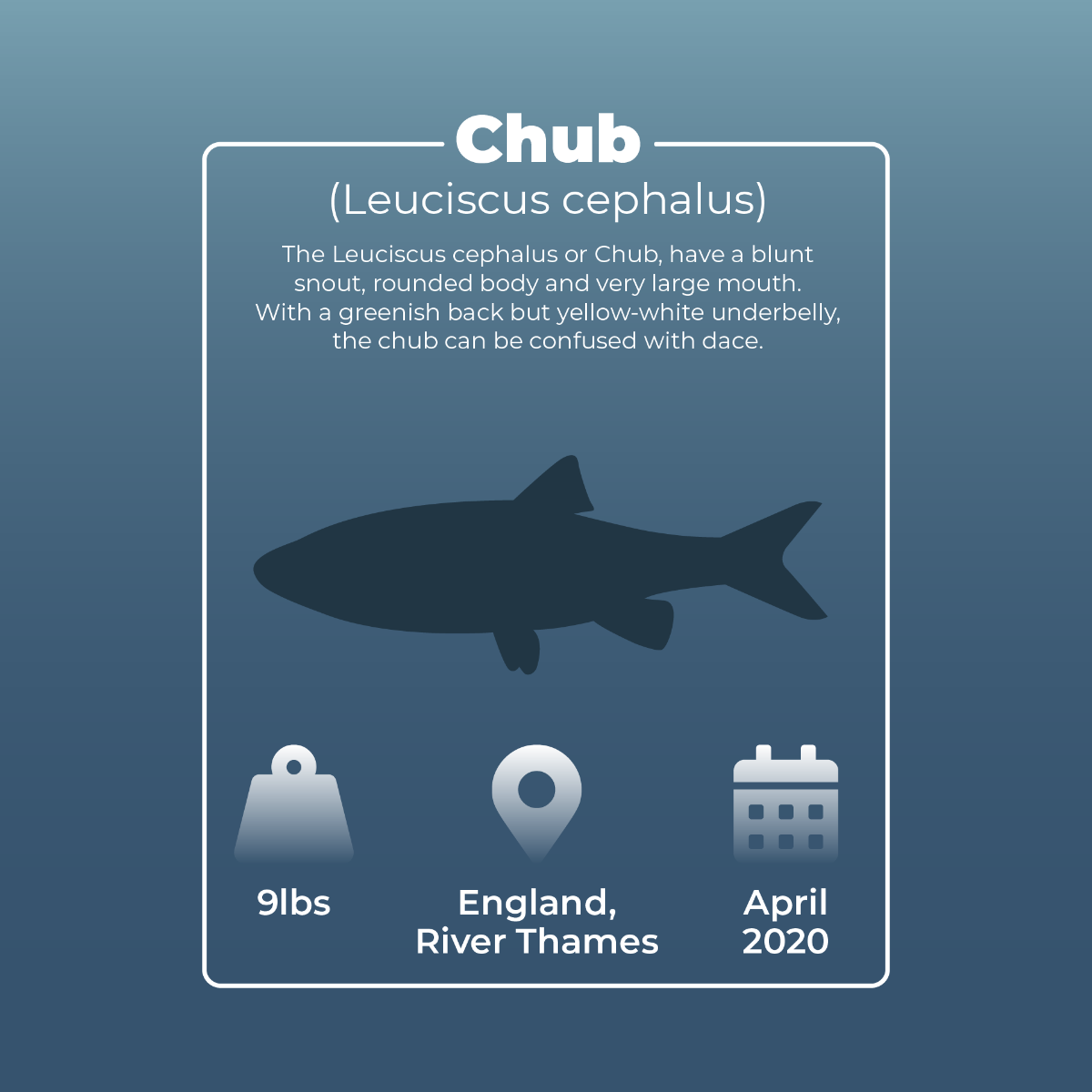
TOP TIP: A great method for catching chub is trotting. You can cover a large stretch of the river working your stick float near to snags, or feeding regularly with maggots or bread to encourage the chub to feed in your swim. One thing is for certain; if you keep feeding sooner or later if the chub are near you’ll be in for some action.
Source: “Dream End to Greatest Ever River Season”. Angling Times. 2020.
Common Sturgeon (European Sturgeon)
With a body structure similar to sharks, the Common Sturgeon can grow up to 6m long and boast elongated bodies, a flattened snout, barbels and a small mouth.
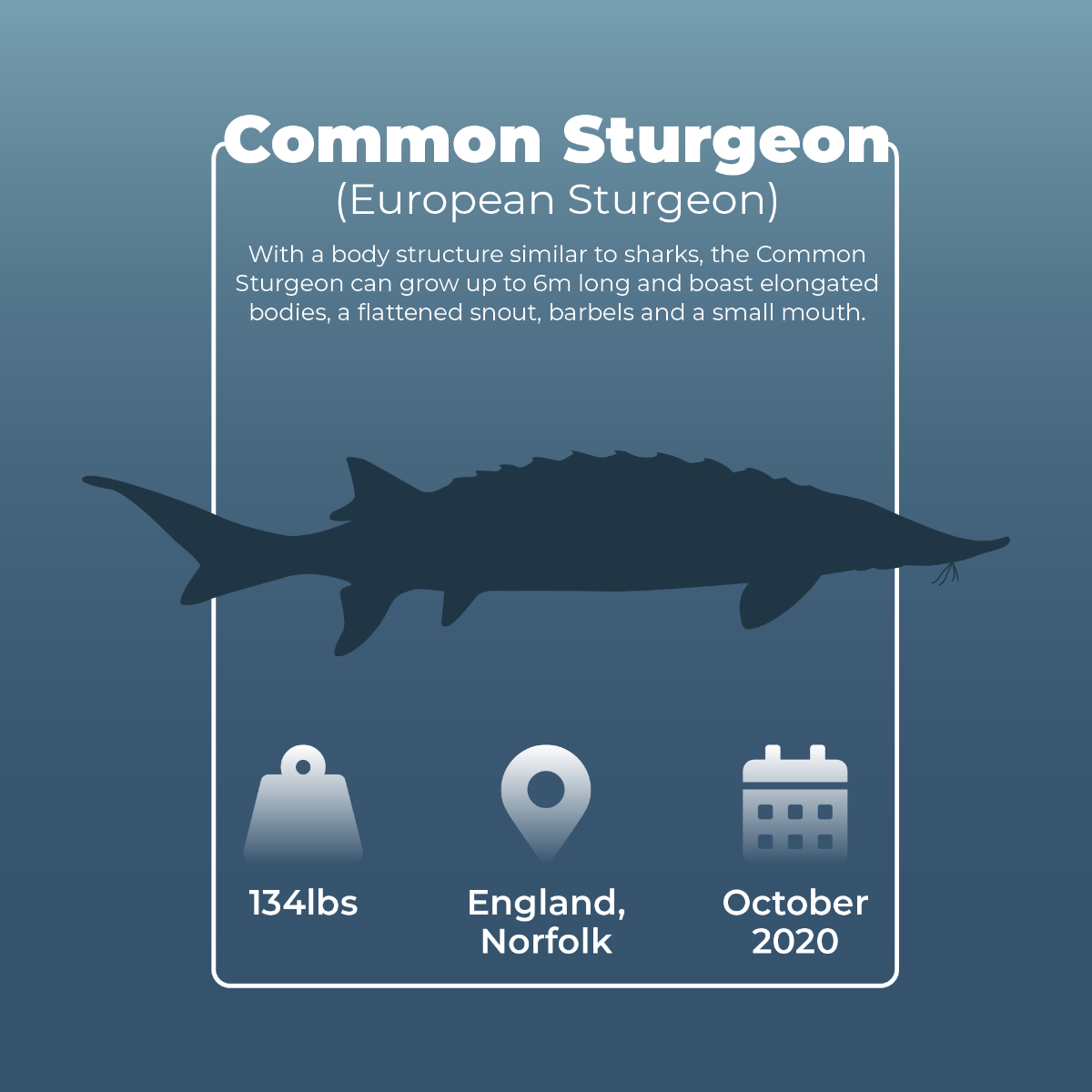
TOP TIP: Along with heavy-duty rods, reels and braid, bait-wise, a specimen sturgeon can be attracted to freshly caught pike minnows, large strips of salmon, mesh sacks of salmon roe or large salmon heads.
Source: “Enormous 100lb Plus Sturgeon – The Perfect Birthday Gift – Aaron Lawther”. Angling Times. 2020.
Dace (Leuciscus leuciscus)
Small, slim, with silver flanks and olive green backs, unlike Chub, Dace have a concave curve on the back edge of their fins.
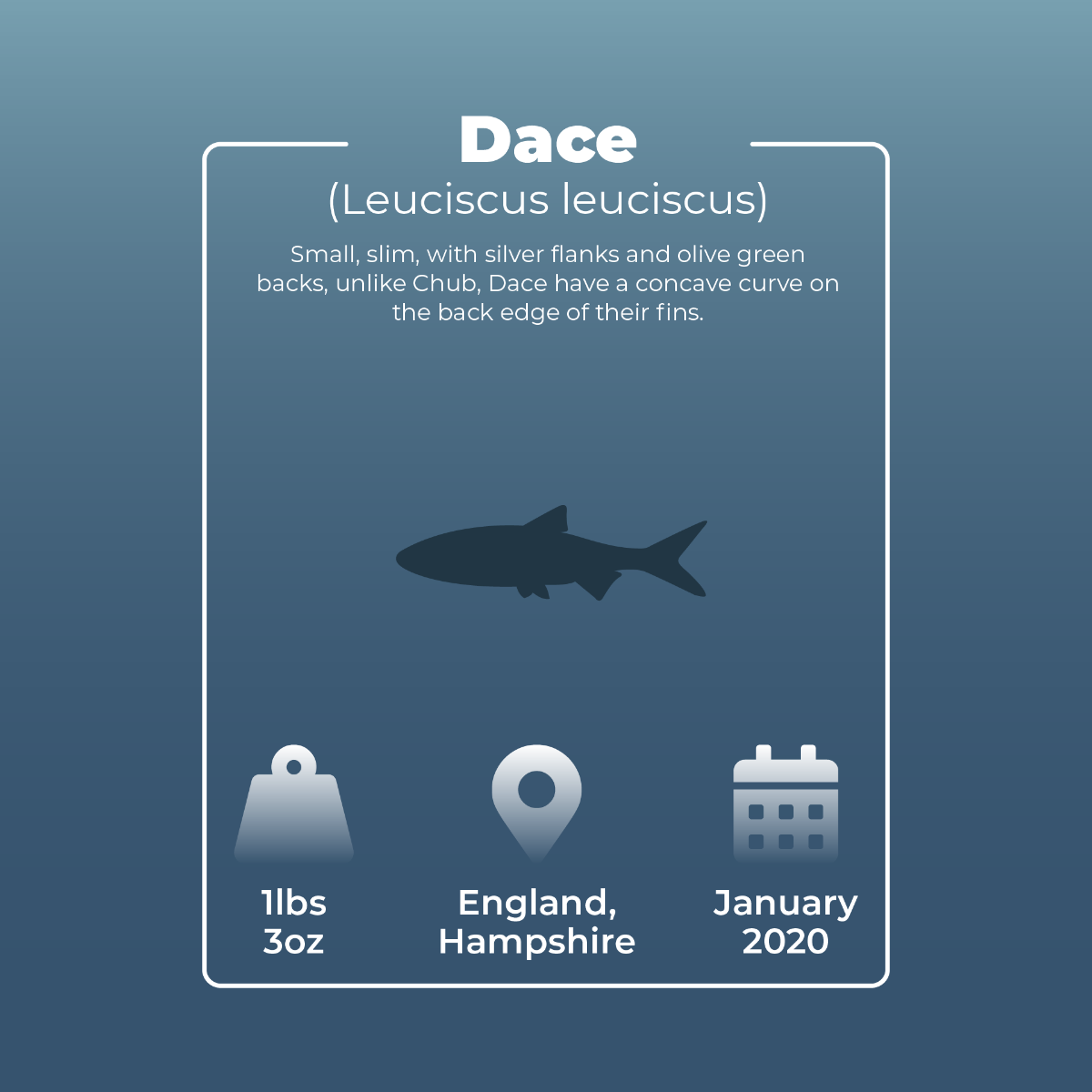
TOP TIP: Live many silverfish, Dace can be caught on a range of baits such as bread, hemp, berries, casters of worms. Try imitation baits such as maggots too to save time replacing baits.
Source: “Monster Dace Just 2oz Short of the Record”. Angling Times. 2020.
Eel (Anguilla anguilla)
Born in the Sargasso Sea, Eels take three years to reach the UK/Europe streams where they mature its elongated, cylindrical body shape to dark green/brown, a silvery belly and one pair of pectoral fins.
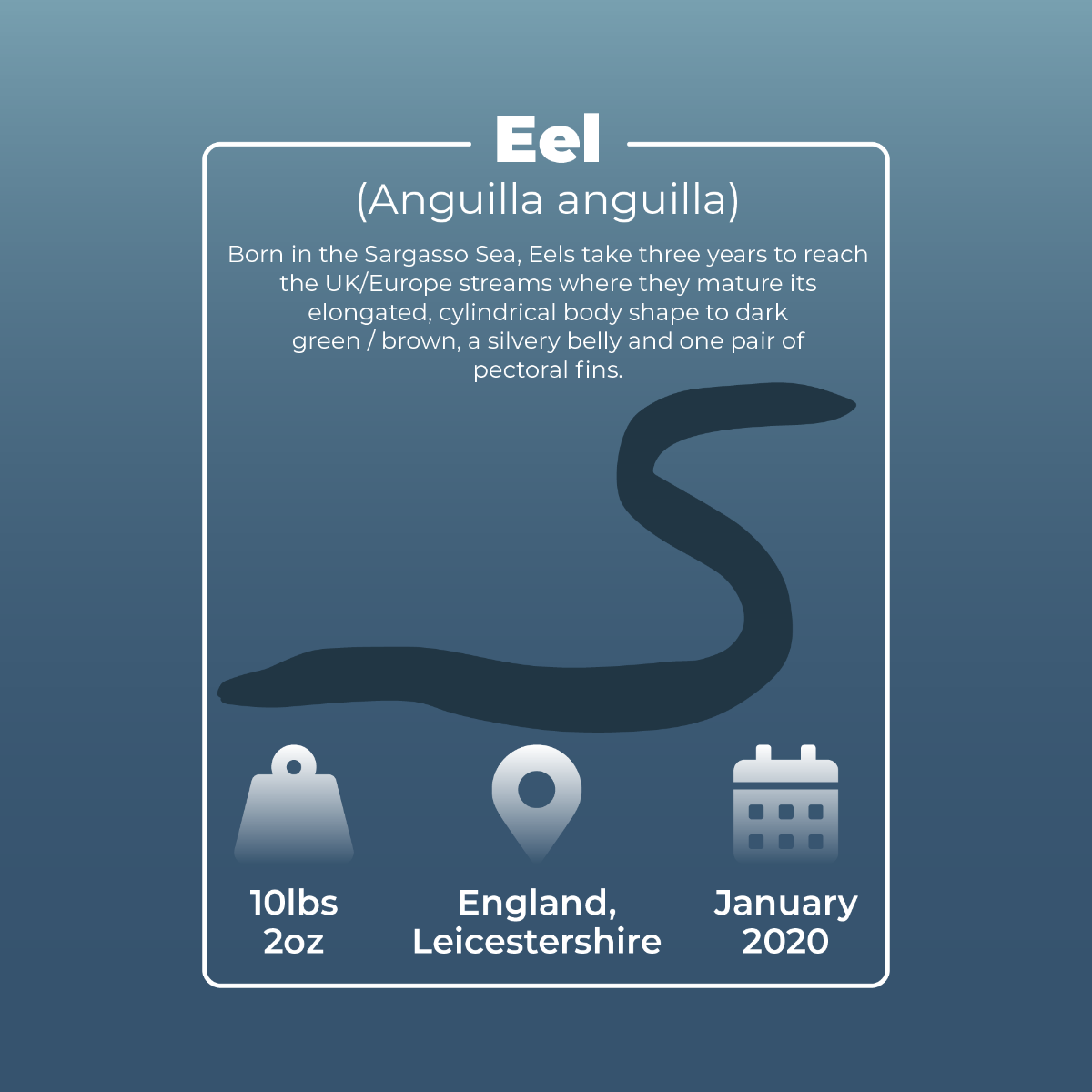
TOP TIP: A lover of dead maggots, a big eel is a strong fighting fish so tackle needs to be fit for purpose such as a pair of through action 2lb 4oz test curve carp rods. You should expect an eel to swim backwards and will try its best to reverse into any nearby snags when hooked.
Source: “Are Eels Making a Comeback?”. Angling Times. 2020.
Grayling (Thymallus thymallus)
Also known as the Lady of the Stream, Grayling are silver with large scales and a pale belly and boast a huge dorsal fin.
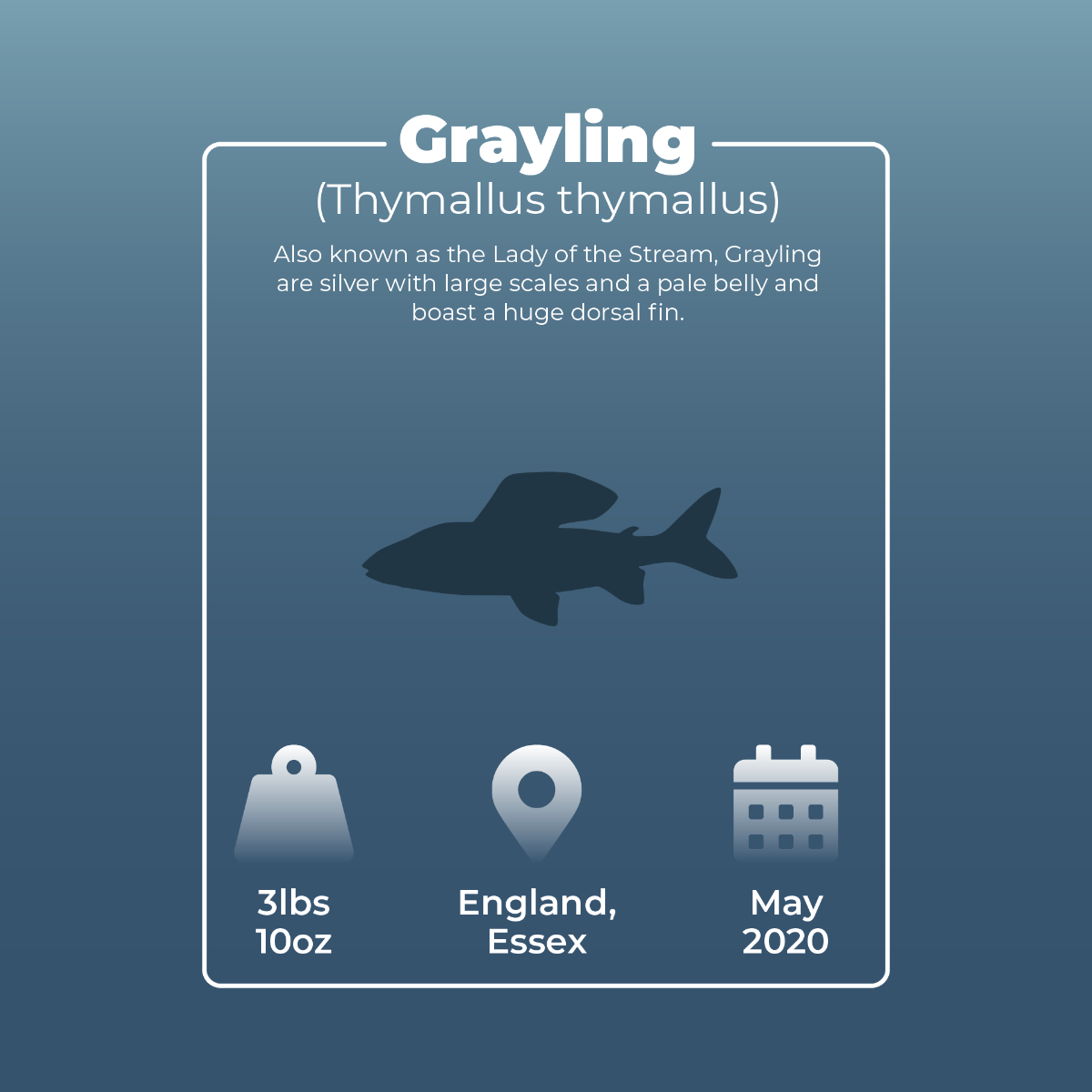
TOP TIP: Any grayling over a pound is a true wild river specimen. To single out a specimen try using sweetcorn or other larger baits. Due to the small mouth a grayling has, the small fish simply can't fit larger baits in their mouth, allowing you to be selective. You can also do this by sight fishing for the specimens in the shoal on the clear rivers, this can be done with bait or on the fly.
Source: “Anglers Get Winter Grayling Bug”. Angling Times. 2020.
Perch (Perca fluviatilis)
The Perca fluviatilis is known for its dark stripes, greeny-brown back, orange fins and spiky dorsal fin.
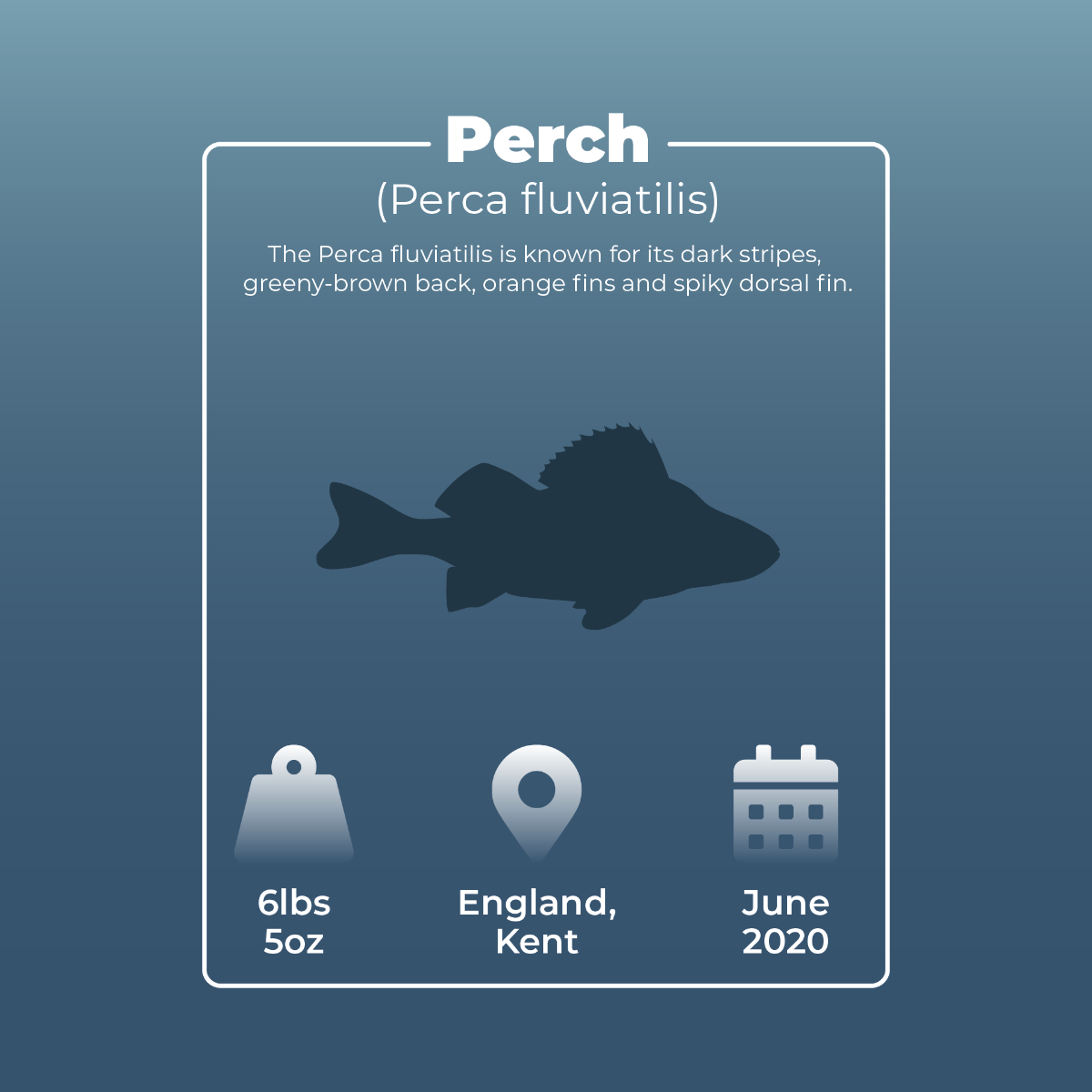
TOP TIP: Perch will fall to all manner of baits, however, the preferred choice would be maggots, lobworms, prawns and live baits (if and when allowed). A good tactic is to feed plenty of worms and then use worm or maggot hookbait over the top of where the loose feed was introduced.
Source: “New Dutch Perch Record: 56 CM!”. Fishing in Holland. 2020.
Pike (Esox lucius)
With a flattened snout and a large mouth full of sharp teeth, Pike uses its long, torpedo-shaped body for fast acceleration and its olive and cream colouration for camouflages.

TOP TIP: In cold conditions, Pike are looking to conserve valuable energy. This is why deadbaiting can be so effective, and there is a range of baits to use, the main choice being sea baits; are more readily available and tend to be more robust and cast better, and natural baits; ideal to use on waters that haven’t seen too much pressure.
Source: "Biggest Fish Campaign”. LAV Angling Association. 2020.
Roach (Rutilus rutilus)
A slim-bodied fish, Roach have bright silver flanks with a pale cream underbelly and orange-brown fins. Its small mouth has an extended top lip to indicate its preference for bottom-feeding.
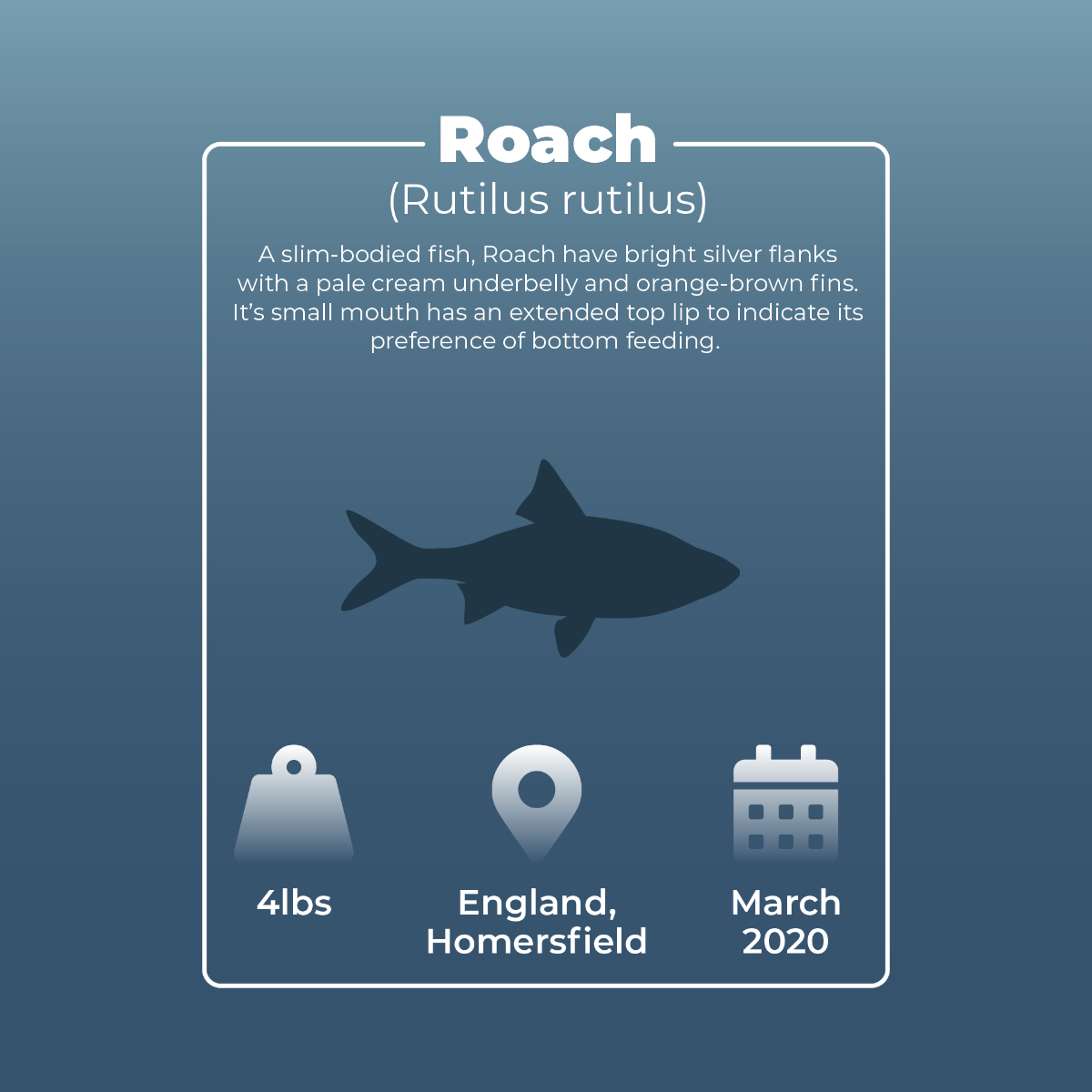
TOP TIP: During the colder months, fish for roach using white maggots in maggot feeders. Come March, consider swapping maggot feeders for groundbait feeders as the lake becomes much more active – meaning that as soon as my maggot hookbaits are cast out, a small roach has taken them.
Source: “Roach just 4oz off the Record Caught by Mistake”. Angling Times. 2020.
Rudd (Scardinius erythrophthalmus)
Coppery gold in colour, Rudd have with bright red fins and a small head with big eyes. Rudd have an upturned mouth for primarily surface feeding.
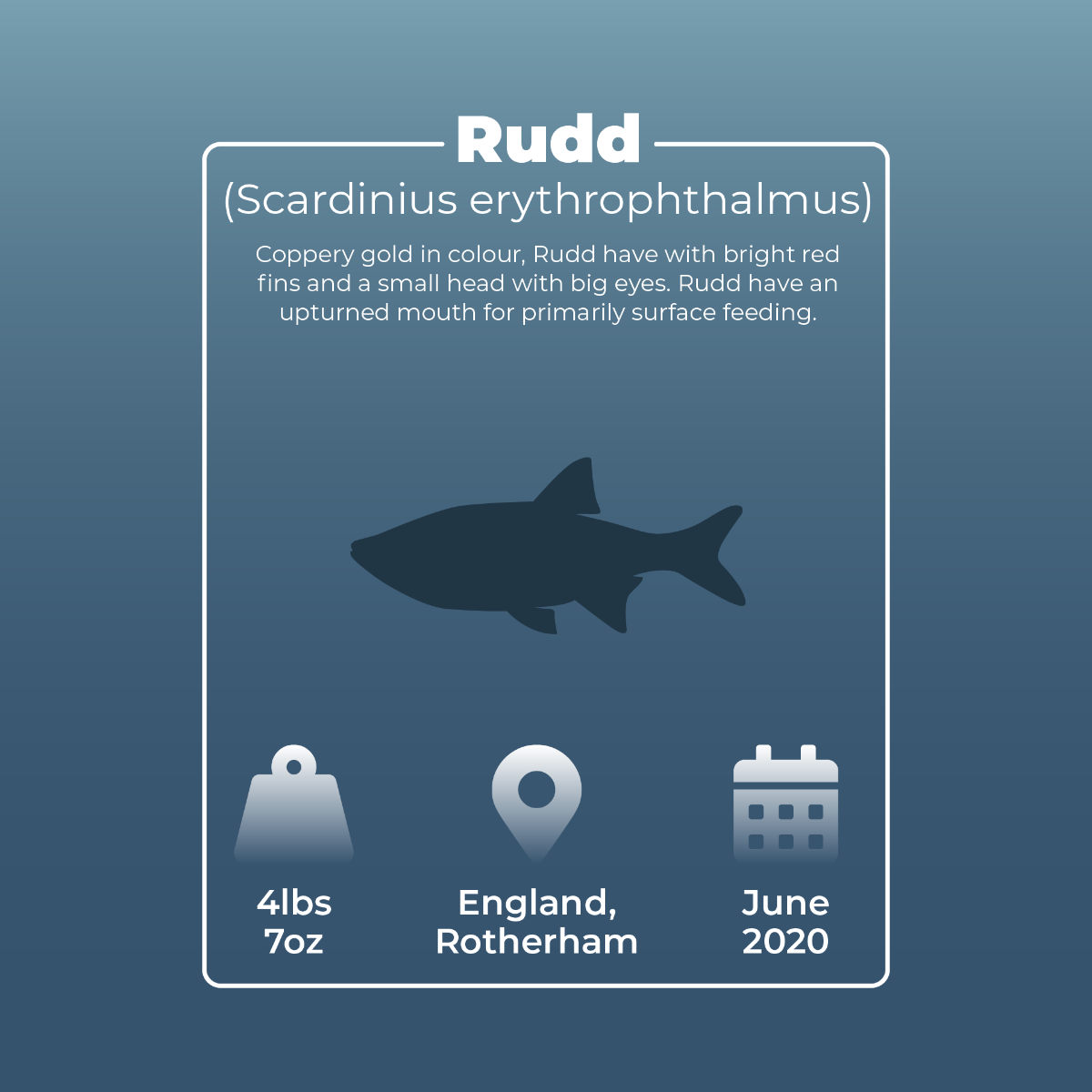
TOP TIP: For rudd, try using the waggler on top for loose fed casters. Try feeding a few pellets and a soft expander pellet but change to big chunks of lobworm is you are waiting too long for a bite!
Source: “Joshua Dorka 4lb 7oz Rudd”. Drennan Catch Reports. 2020.
Tench (Tinca tinca)
Also known as Tinca tinca, Tench have olive green colouration with a deep tail and rounded fins as well as a humped back and rounded head.
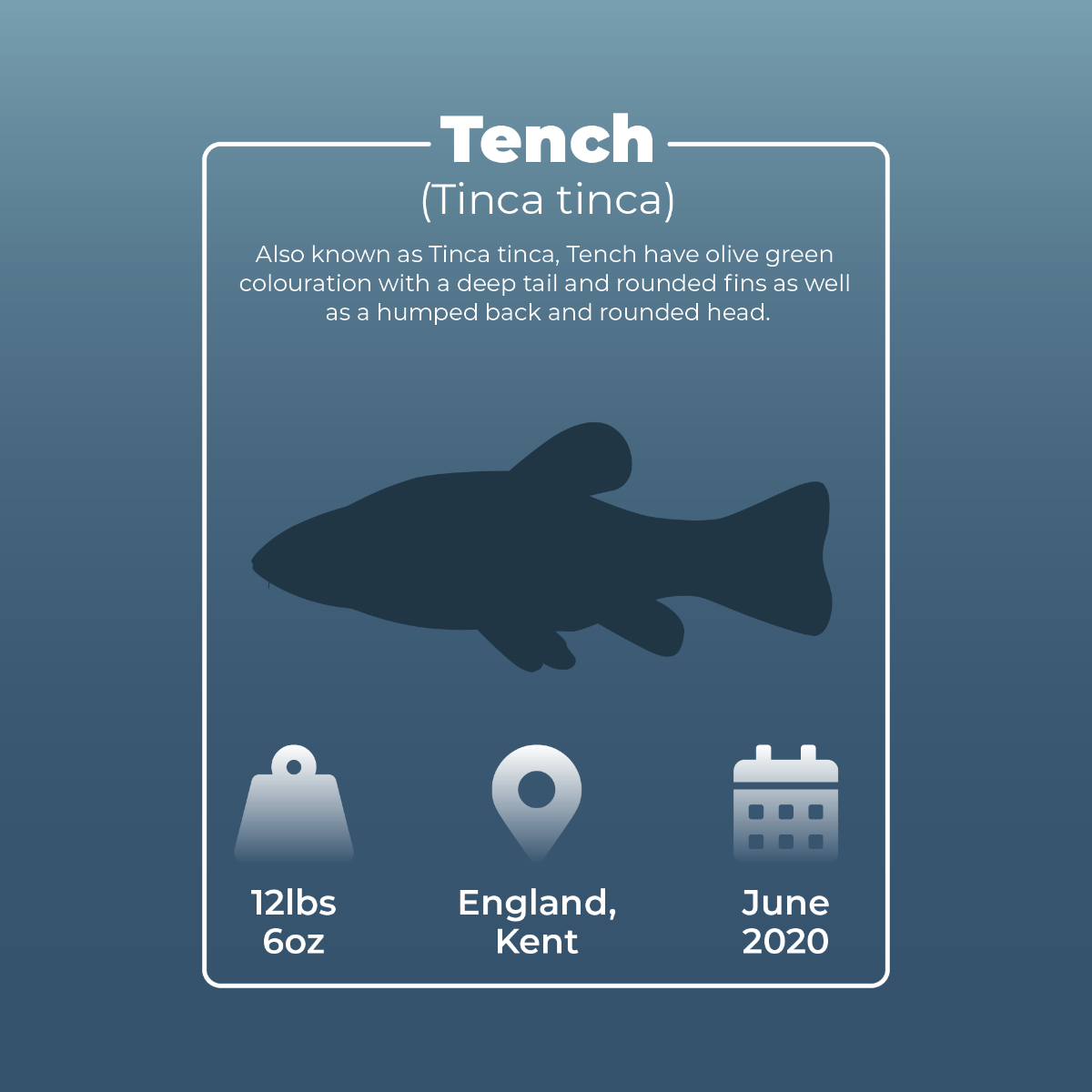
TOP TIP: Aim for bottom bait presentations, whether your float fishing or ledgering, tench love a carpet of groundbait (balled in or via a feeder) and numerous particles like hemp, pellets and boilies. Keep your hookbait static on the bottom in this area and sure enough, if the tench are present and feeding you are in for some action.
Source: "Tench Brace of a Life Times for Drennan Cup Runner Up”. Angling Times. 2020.
Brown Trout (Salmo trutta)
Also known as Salmo trutta, the Brown Trout has a golden-brown appearance, yellow belly and many black and red spots all over the body and its jaw extends beyond the eye.
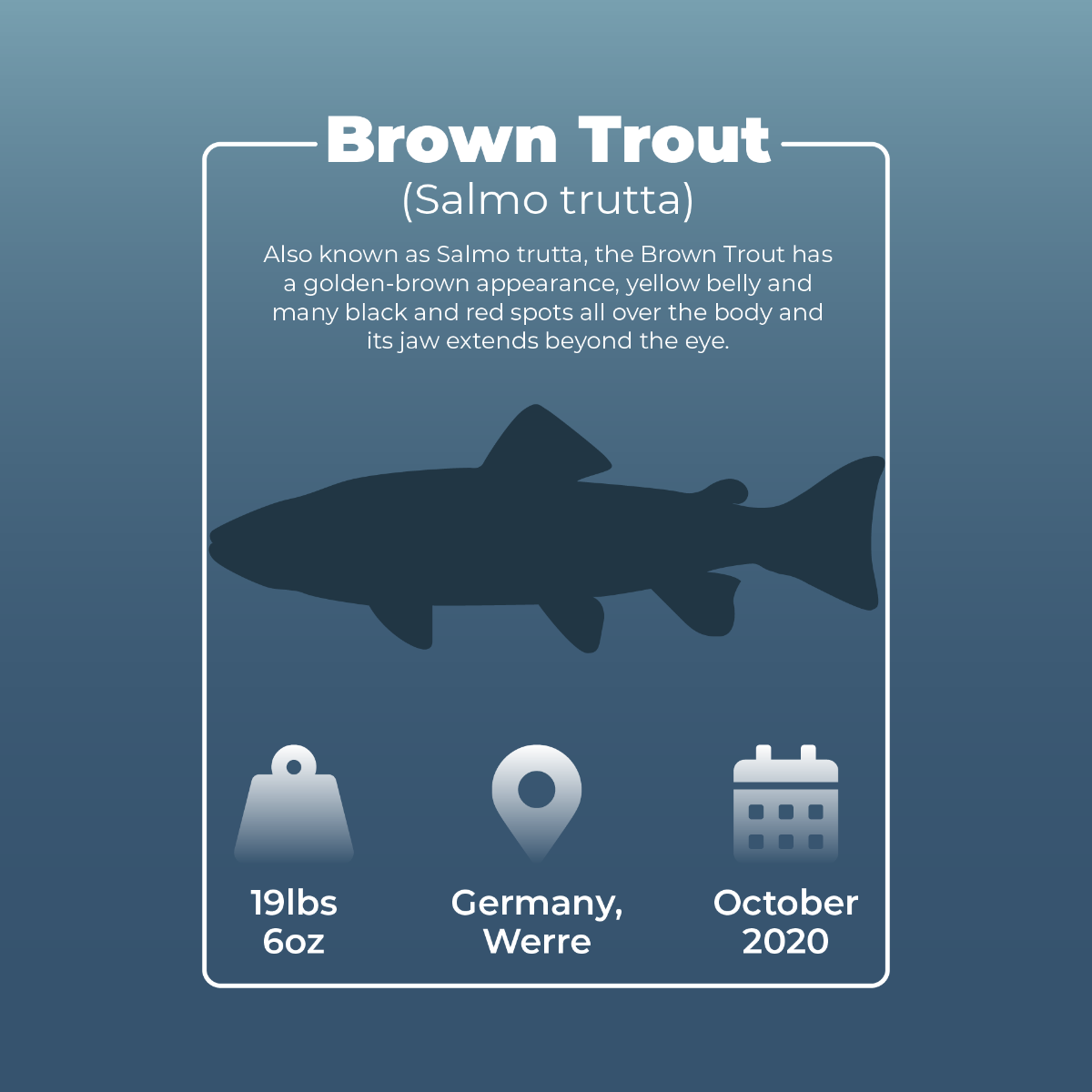
TOP TIP: Worms are a great bait for fishing for Brown Trout in rivers or try using fish lures with big rips and jerks along with a fast retrieve, as this best mimics a baitfish that trout would pursue.
Source: “Las Buitreras week report 5, 2020”. Solid Aventures. 2020.
Rainbow Trout (Oncorhynchus mykiss)
Primarily silver in colour, Rainbow Trout are covered in black speckles with pink and blue bands from the head and along the body.
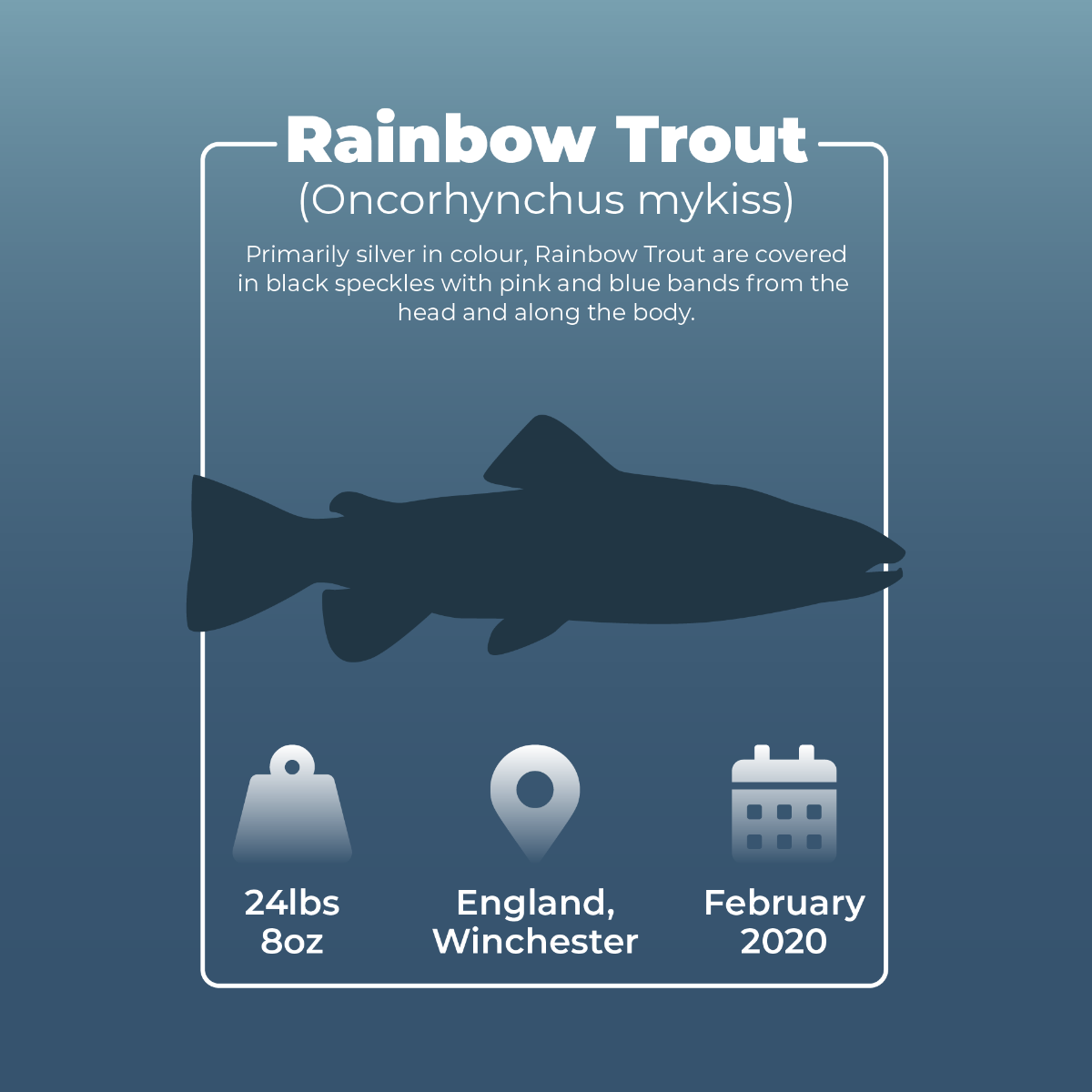
TOP TIP: Maggots are a favourite bait for many trout anglers with rainbow trout loving more that artificial on the right day. Try presenting white maggots as a popped up ledger rig.
Source: “Biggest Rainbow In a Decade”. Angling Times. 2020.
Wels Catfish (Silurus glanis)
The Wels Catfish have long slender bodies, dark brown in colour, broad heads and wide mouths. Its upper jaw has two long barbels and four shorter barbels on the lower jaw.
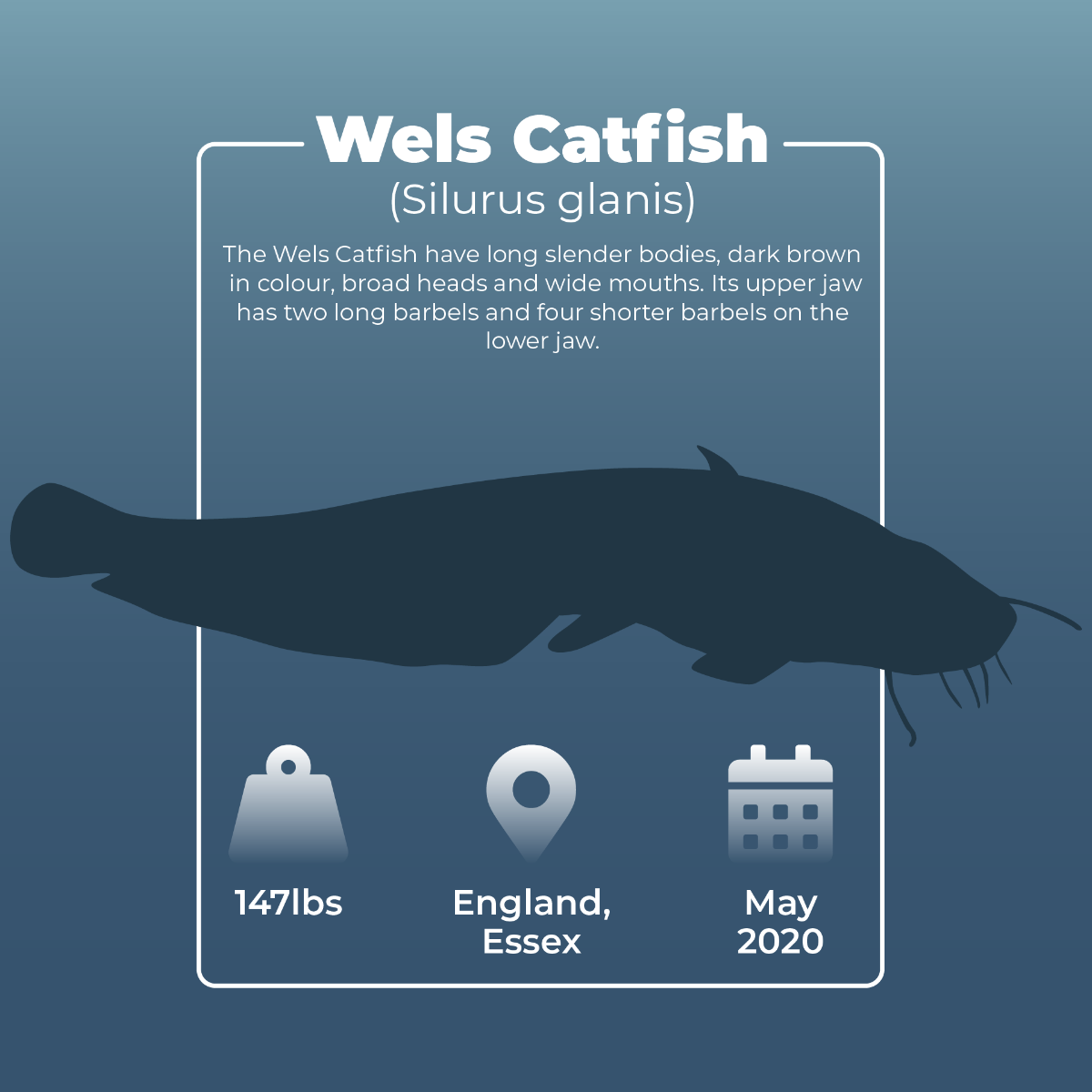
TOP TIP: Open water if your friend when fishing for a wels catfish, try using as much large smelly pellet and fishmeal boilies as as well as live worms or minnows, cut-bait, or smelly artificial bait, like catfish chunks or dough!
Source: “Britain’s Heaviest Catfish”. Anglers Mail. 2020.
Zander (Sander lucioperca)
A member of the perch family, Zander are often a greeny brown colour with dark vertical markings and cream belly. It’s two long front teeth give it a vampire-looking appearance.
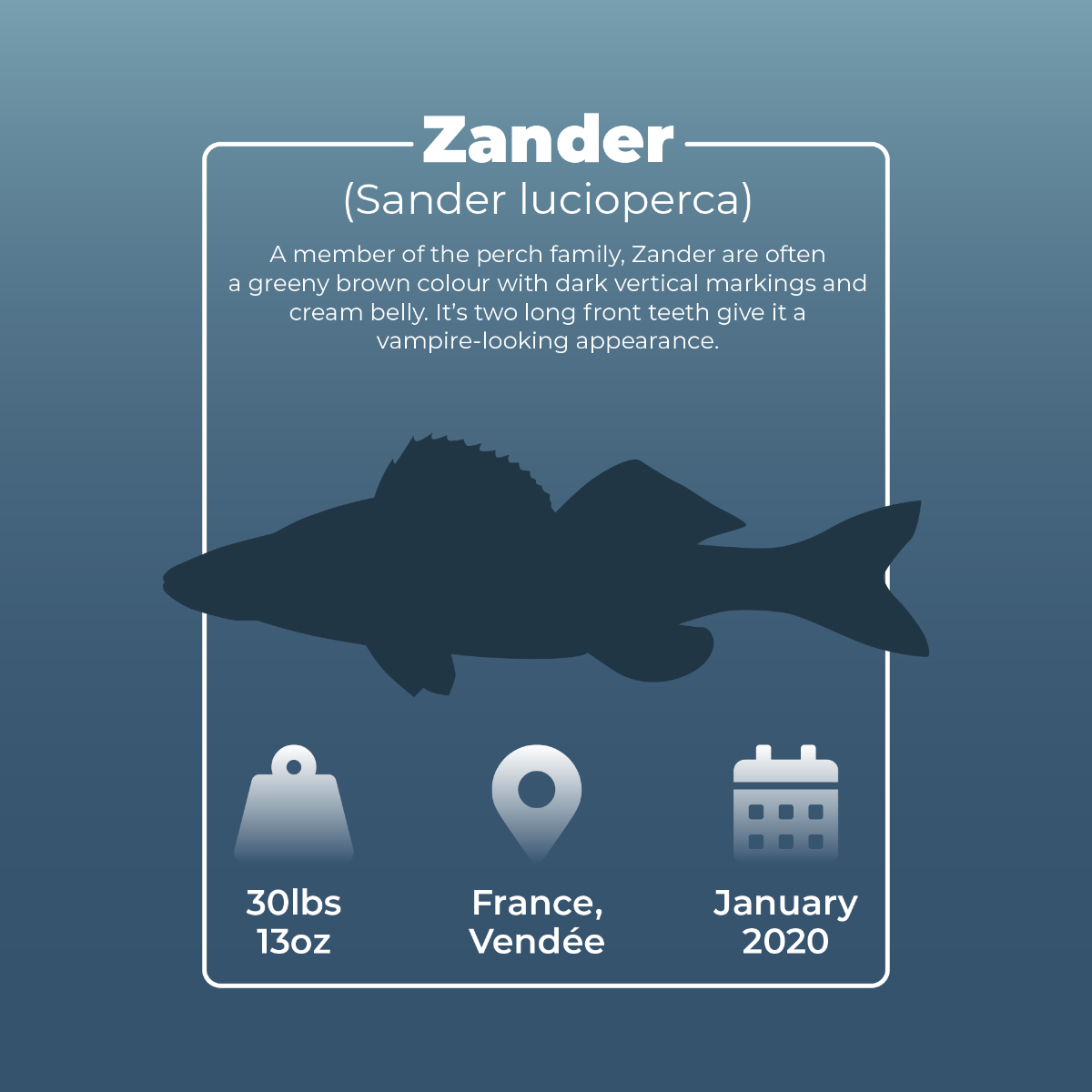
TOP TIP: In comparison to pike and perch, zander have relatively small mouths so try small lures and deadbaits. To avoid smaller zander, live baiting at dusk is your best chance.
Source: “Vendée. He catches a 13.980 kg pike perch: It's the fish of my life, it's exceptional". Ouest-France. 2020.
2020 Catch Report Results
Wondering when the best time of year to go fishing is?
According to these impressive catches, January and July are the most popular months for bagging a specimen, with February, September and October close behind!
Hot Spots for Specimen Fishing
It looks like Essex is the place to go if you want to catch a big one, with two of our impressive catches being caught in this English county, the Grayling and Wels Catfish. Equally admirable is Dorset with our Impressive Common Bream and Crucian Carp being landed there!
For those wanting to try river angling in the new year, the River Thames is a worthy stop as again 2 of our catches in our 2020 line up was caught there. If you are looking for a specimen barbel or chub, the Thames is the place to cast your line.
If you are seeking a trip across the UK borders, it seems the Netherlands and Germany is the place to go for Perch, Pike and Brown Trout. For closer to home, France has some great fishing opportunities too with huge Leather Carp and Zanders!
Do you have an Impressive Catch caught in 2020?
With collecting data for our Most Impressive Catches of 2020, we found it difficult to find many sources in Europe, so if you know of a bigger catch in Germany, France or in the Netherlands, please let us know! You can share your impressive catch reports with us at catch@anglingdirect.co.uk or through our social media.
---------------------------------------------------------------------------------------------------------------------------------------------------------------------------------------------
Research /Influential References:
"Angling Records in the UK". Wikipedia.org. [Accessed 1/12/20]
"Biggest Fish Ever Caught Chart". HMY.com. [Accessed 1/12/20]
"Coarse Fish Species Guide". BadAngling,com. [Acessed 15/12/20]
"Fish Species". CanalRiverTrust.Org. [Accessed 1/12/20]
"French Federation of Fishermen at Sea, Fish Records". FFPM-National.com. [Accessed 1/12/20]
"Natural History Museum Checklist of Freshwater Species". NHM.ac.uk. [Accessed 1/12/20]
"NEW SERIES: LEGENDARY CATCHES AND THE BRITISH RECORD FISH COMMITTEE". AnglingTrust.net. [Accessed 1/12/20]
"UK Fish Species". SpeciesHunter.co.uk. [Accessed 1/12/20]
"UK Rod Caught Fish Records". Fish UK.com. [Accessed 1/12/20]
“Der Märkische Angler“. Marcel Weichenhahn - Landesanglerverband Brandenburg e.V. LAVB.de. [Accessed: 17/12/20]
"Henning Stühring (Editor in Chief)". Fisch & Fang.de. [Accessed 17/12/20]
"Landesanglerverband Mecklenburg Vorpommern e.V."LAVB.de. [Accessed: 17/12/20]
Image References:
Grass Carp, Crucian Carp, Barbel, Tench, Perch, Chub, Grayling, Catfish, Zander, Roach, Rudd, Eel, Common Bream, Silver Bream, & Dace images. BadAngling.com. [Accessed 16/12/20]
Common Sturgeon. NBC25news.com. [Accessed 16/12/20]
Common Carp, Mirror Carp, Leather Carp, Brown Trout & Rainbow Trout images. NineoaksFisheries.co.uk. [Accessed 16/12/20]
Hybrid F1 Carp. Wiki.FishingPlanet.com. [Accessed 16/12/20]
Pike & Atlantic Salmon images. Digitalmedia.fws.gov. [Accessed 16/12/20]


